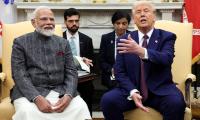The international community remains on edge as Pakistan and India have spent most of the past week exchanging accusations and war threats. In the aftermath of the Uri attack, the Modi government has been raising tensions with Pakistan in an effort to deflect attention from its own brutalities in Occupied Kashmir.
Media in both countries has taken the lead in supplying enough fuel for rabid nationalist fervour. It is quite unfortunate that some irresponsible American analysts are also adding further fuel to the fire, provoking India to take extreme steps against Pakistan. This intellectual bias must be discouraged because our dogmatic mindsets will put us on a path toward perpetual warfare. Rather, we need to look at the situation objectively on its merit.
Why is it that the Indian military establishments and political elites always seek to rely on sabre-rattling more than diplomacy in the wake of attacks? The answer lies in the understanding of India’s security culture, along with the gradual rise of the right-wing Hindutva forces. The young generation of India has been brainwashed into believing Pakistan to be the enemy country without an adequate understanding of the historical context.
It is an open secret now that India has spent enormous resources in Afghanistan over the past decade, using it as a base to instigate trouble in Balochistan and our tribal areas. The developments over the past few weeks indicate that, despite repeated denials, the Modi government is still working on limited military options including surgical strikes against Pakistan.
This shows India’s utter lack of understanding of the changing strategic realities in the region. Indian leaders and the public need to get rid of the misunderstanding that they will ever be able to launch a conventional military offensive against Pakistan without crossing the nuclear threshold.
It is highly unfortunate that South Asia continues to be a short-fuse flash point but few policymakers on both sides of the border are interested in cementing a stable security relationship at both the strategic and the tactical levels. Some analysts have suggested denuclearisation of the region in the recent past but that is unlikely to become a realistic solution in the near future. Given the inherent risks in the confrontation between nuclear-armed countries, the best choice both countries have is to minimise the likelihood of low-level violence.
Over the past decade, the development of security arrangements in South Asia has mainly been explained in terms of the ‘stability/instability paradox’. According to the paradox, due to the low likelihood of conventional war escalating to the nuclear level, strategic stability has lowered the potential costs of conventional conflict between Pakistan and India. On the other hand, by reducing the dangers of launching a conventional war, strategic stability has made the outbreak of ‘small-scale violence’ more likely.
In other words, the presence of nuclear weapons in the strategic equation developing between the two countries has made it quite easy for both countries to pursue a limited war strategy under a nuclear umbrella. Kenneth Waltz, the father of the neorealist theory of international relations, says that “nuclear weapons tempt countries to fight small wars under the stability/instability paradox.” Another American expert, Jeffrey Knopf, echoes the same view that “flare-ups in South Asia since the Indian and Pakistani nuclear tests of 1998 indicate the continued relevance of Glenn Snyder’s stability/instability paradox.”
The impossibility of fighting a full-scale conventional war has allowed both India and Pakistan to fight at low levels. But concerns remain regarding the likelihood of any such low-level conflict escalating to an all-out nuclear war in the region.
It is pretty much obvious now that another large-scale terrorist attack in India would bring South Asia to the brink of nuclear confrontation. Many Western experts have expressed fears that the inability of the Pakistani government to deal with terrorist groups or the possibility of India carrying out any surgical military strikes inside Pakistan may eventually lead to a nuclear exchange.
Another likely threat to strategic stability in South Asia is that Pakistan, being a weak state in conventional warfare, has adopted policies designed to ensure that an Indian conventional attack on Pakistani soil would automatically trigger nuclear escalation. To this end, Pakistan’s nuclear establishment has introduced tactical nuclear weapons that may elicit a nuclear response from India.
Two lessons can be learned in the aftermath of the terror attack in Uri. First, policymakers in both Pakistan and India are unable to appreciate the gravity of the volatile security situation in the region. Second, both nations have assumed aggressive military postures over the past few years, lowering the nuclear threshold in South Asia. An important means of promoting peace and strategic stability in South Asia has to do with peaceful diplomatic efforts rather than with military options.
It is time for both neighbours to put aside their animosity and take immediate steps to resolve all long-standing issues including Kashmir dispute. Our civilian and military rulers have to understand that there will be no winners in a nuclear war in South Asia.
Email: rizwanasghar5@unm.edu
Beijing was among first to denounce the tariffs, calling them “unjustifiable” and vowing strong countermeasures
With this unprecedented buildup, Diego Garcia has transformed into ticking time bomb of apocalyptic power
Pakistan is among world’s most climate-vulnerable nations, despite contributing minimally to global emissions
‘Azazeel’ is perhaps the most controversial novel to come out in Egypt this century
Dr Haroon Ahmed was an exceptional person, a precious human being who strived, throughout his long life
Pakistan can't afford another status quo budget so it must be budget of imagination, risk-taking and system-level...







